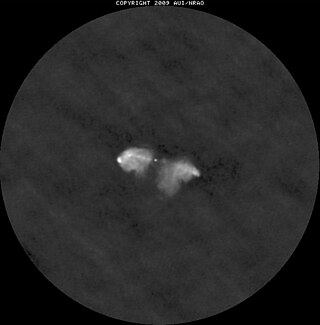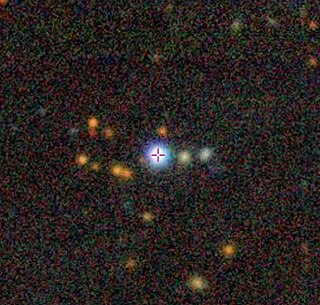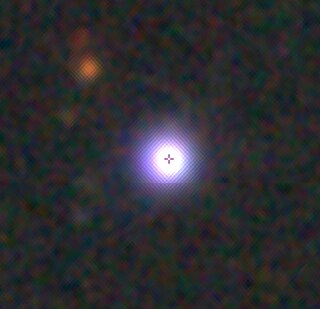
3C 171 is a Seyfert galaxy located in the constellation Lynx, classfied as a radio galaxy, containing an extended emission-line region. It is also a relatively isolated galaxy, not belonging to any other rich galaxy clusters.

3C 249.1 is a Seyfert galaxy located in the constellation Draco. It hosts a powerful radio source and is located at redshift 0.3115, with a peculiar radio structure. One of its radio lobes is classified as having a Fanaroff-Riley classification Type II, while the other lobe has no features nor containing hotspots.

3C 285 is a radio galaxy located in the constellation Canes Venatici. It is located about 1 bilion light years away. It is a Fanaroff-Riley 2 radio galaxy and is hosted in a disturbed spiral galaxy.

NGC 3862 is an elliptical galaxy located 300 million light-years away in the constellation Leo. Discovered by astronomer William Herschel on April 27, 1785, NGC 3862 is an outlying member of the Leo Cluster.

NGC 708 is an elliptical galaxy located 240 million light-years away in the constellation Andromeda and was discovered by astronomer William Herschel on September 21, 1786. It is classified as a cD galaxy and is the brightest member of Abell 262. NGC 708 is a weak FR I radio galaxy and is also classified as a type 2 Seyfert galaxy.
4C +48.48 is a radio galaxy located in the constellation Cygnus. At the redshift of 2.343, it is one of the most distant galaxies ever seen, since light has taken at least 11 billion light-years to reach Earth.

IRAS F11119+3257 or simply as F11119+3257, is a galaxy located in constellation Ursa Major. With a redshift of 0.187580, it has a light travel time distance of 2.5 billion light-years and is considered an ultraluminous infrared galaxy (ULIRG).

PKS 0438-436, also known as PKS J0440-4333, is a quasar located in constellation Caelum. With a high redshift of 2.86, the object is located 11.2 billion light-years from Earth and is classified as a blazar due to its flat-spectrum radio source, (in terms of the flux density as with α < 0.5 and its optical polarization.

PKS 2126-158, also known as PKS 2126-15, is a quasar located in Capricornus. It has a redshift of 3.268000, which corresponds to the distance of 11.5 billion light years. It is classified as a gigahertz peaked-spectrum quasar (GPS) with a flat-spectrum radio source and a blazar, a type of active galaxy shooting an astrophysical jet towards Earth.
TXS 1545-234 known as NVSS J154817-233701, is a radio galaxy located in the constellation Scorpius. It has a redshift of 2.755.

MRC 2011-298 is an elliptical galaxy with an active galactic nucleus, located in the constellation of Sagittarius. It is located 2.1 billion light-years away from Earth. MRC 2011-298 is the brightest cluster galaxy in the galaxy cluster, Abell 3670 and classfied as a dumbbell galaxy, an optical system with two galactic nuclei separated by 7″, corresponding to ≃17 kpc according to the adopted cosmology, with similar magnitude and a common stellar halo. The galaxy is known to have an ellipticity of ε = 0.28 and a position angle of PA = 24° that is measured from north to east.

MRC 0316-257 is a radio galaxy located in the constellation Fornax. Its redshift is 3.13, making the object located roughly 11 billion light-years from Earth.

4C +72.26 known as NAME TX J1908+7220, is a radio galaxy located in the constellation Draco. At the redshift of 3.53, the galaxy is located roughly 11.5 billion light-years from Earth.
PKS 0529-549 known as MRC 0529-549 and PKS B0529-549, is a radio galaxy located in the constellation Pictor. At the redshift of 2.57, the object is located nearly 10.8 billion light-years away from Earth.

4C +41.17 is a radio galaxy located in the constellation Auriga. With the redshift of 3.79, it is located nearly 11.7 billion light-years from Earth. At the time of its discovery in 1988, it was one of the most distant galaxies ever seen.

PKS 0451-28, also known as MRC 0451-282, is a quasar located in the constellation of Caelum. Its redshift is 2.55, estimating the object to be located nearly 10.8 billion light-years away from Earth.

4C +26.42 is an elliptical galaxy located in the constellation of Boötes. It has a redshift of 0.063, estimating the galaxy to be located 863 million light-years from Earth. It has an active galactic nucleus and is the brightest cluster galaxy (BCG) in Abell 1795, an X-ray luminous rich cluster (LX 1045 ergs s-1), with an estimated cooling-flow rate of 300 M yr-1.

RX J1633.3+4718 known as RXS J16333+4718 according to VLBI Network observations, is a narrow-line Seyfert 1 galaxy, located in the constellation of Hercules. It has a redshift of (z) 0.116 and is located 1.75 billion light years from Earth. The first known reference to this galaxy comes from a radio source which was identified in 1995 in the IRAS catalogue as F16319+4725.

3C 196.1 is a low-excitation radio galaxy located in the constellation of Hydra. It has a redshift of 0.198 and was first discovered as an astronomical radio source in 1965. This object resides as the brightest cluster galaxy (BCG) of a cool core galaxy cluster CIZA J0815.4-0308 located at the same redshift, with its source being best described as a HyMOR.

3C 356 is a distant radio galaxy located in the constellation of Draco, hosted by a merging pair of elliptical galaxies located at redshift (z) 1.079 with two radio cores having a separation gap of 5 arcseconds. It was first discovered as an astronomical radio source by P. Veron from a 3C revised catalogue in 1966 and such, shows an alignment effect at both wavelengths. The X-ray source luminosity for this galaxy is estimated to be 2.5 x 1044 erg s-1.

















